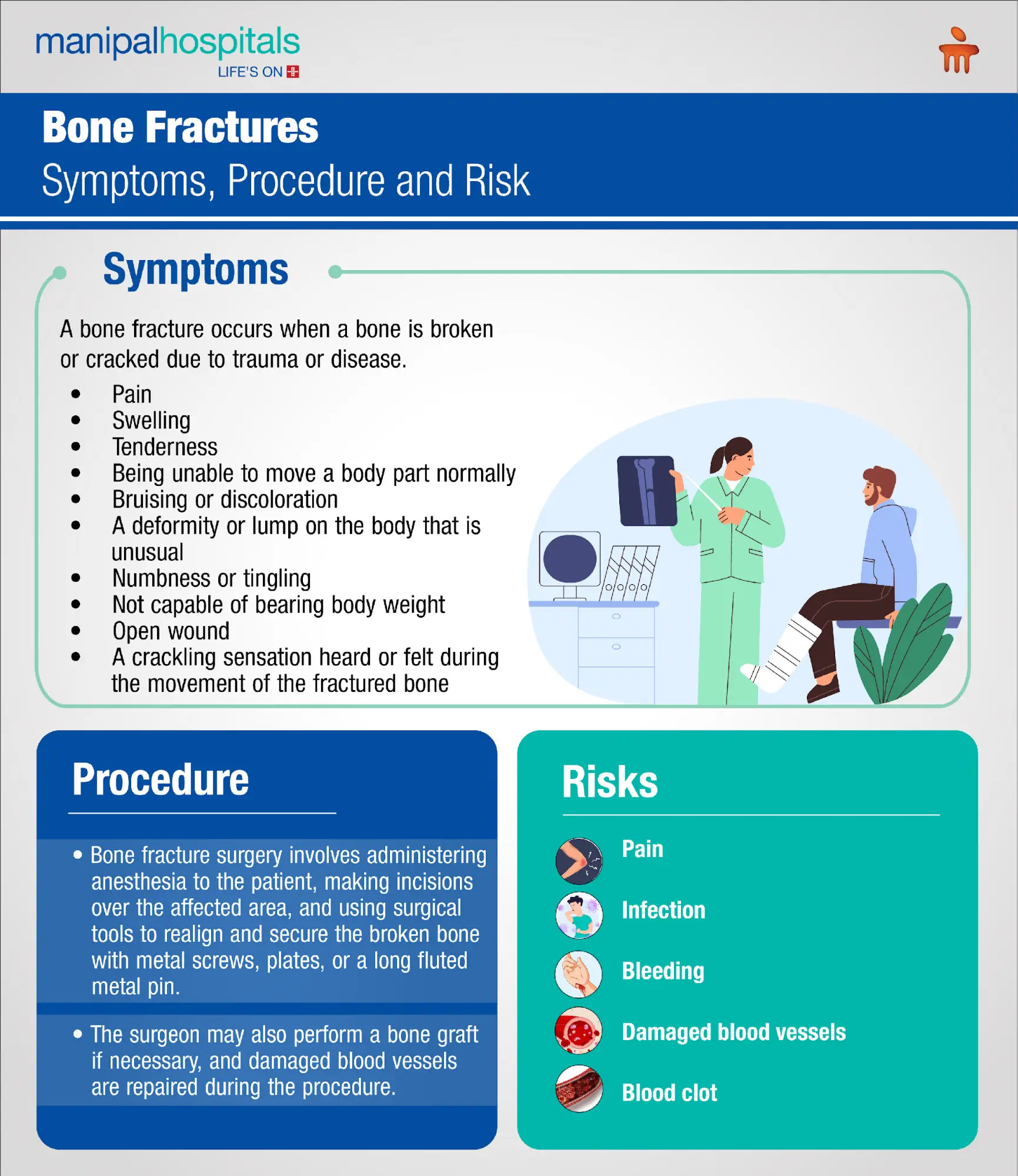
A fracture is a medical term that refers to a shattered bone. It occurs when a partial or complete break in the continuity of the bone occurs as a result of an accident or trauma. Fractures can be moderate (the bone is fractured but still aligned) or severe (the bone is entirely dislocated or fragmented into several pieces). Fractures typically cause discomfort, oedema, and reduced mobility in the affected area, necessitating medical attention for the correct diagnosis and treatment.
It might happen as a result of an accident or a fall. In such cases, the individual experiences severe pain in the affected location and is unable to move the wounded part. It might be felt in any section of the body. A fracture surgery relieves pain and assists in the alignment of misplaced bones.
The surgery is carried out in different ways, depending on the operative site. The surgical technique is standard and is generally used to reduce discomfort and straighten the bones. A fracture can also be caused by osteoporosis, in which the bones become brittle and fracture. A surgical procedure can also help with such medical conditions.

Symptoms of Bone Fracture
Some of the symptoms of bone fracture that can necessitate surgery are listed below:
-
Pain
-
Swelling
-
Tenderness
-
Being unable to move a body part normally.
-
Bruising or discoloration
-
A deformity or lump on the body that is unusual.
-
Numbness or tingling.
-
Not capable of bearing body weight.
-
Open wound.
-
A crackling sensation is heard or felt during the movement of the fractured bone.
When is Surgery for a Bone Fracture Recommended?
The fractured bone can be recovered by surgical methods. But surgeries are recommended only for some major conditions, like:
-
Open fracture
It requires immediate surgical treatment. A serious wound that is seen close to a fracture is a medical issue. Surgery helps with wound closure and protects the injury from bacterial or other infections. The procedure also reduces the chance of developing such health problems and aids in stopping future damage.
-
Comminuted fracture
This is a type of fracture in which the injured bone breaks into two pieces. It can happen due to severe trauma, such as a road accident, a fall, or a severe injury caused while playing a sport. Surgery is required in such situations to join the broken bone. The surgical procedure also helps to lower pain and helps to move the injured part freely without any pain or swelling.
-
Spiral fracture
This is a type of fracture where the bone fractures as a result of twisting or violent limb rotation. The procedure helps in realigning the bone and enables the patient to alleviate any discomfort or swelling brought on by the procedure.
-
Transverse fracture
It results in a 90° perpendicular break in the bones. Long bones frequently exhibit it. With the aid of Open Reduction Internal Fixation (ORIF), a surgeon can treat shattered bones brought on by such traumas.
Procedure for Treating Bone Fracture
Bone fracture surgery is recommended when a broken bone cannot heal properly with casting, splinting, or bracing alone. Anaesthesia is administered to a patient before surgery to ensure they experience no pain or discomfort. Over the area that will be operated on, cuts are performed. It helps insert the necessary surgical tools. In order to detect damage or determine the type of fracture, the surgeon diagnoses the area that will be operated on. Metal screws, plates, or a long, fluted metal pin inserted through the bone's perforations are used to realign shattered and misaligned bones. Bone grafting can be required if the condition is serious. During the procedure, damaged blood vessels are also mended.
Bone fracture surgery aims to provide long-term pain relief. Some of the advantages of bone fracture surgery include:
-
Pain elimination
The fact that surgery for fractures causes less pain is one of its biggest benefits. Incorrectly oriented bones are realigned, and blood vessels are repaired. As a result, the patient is pain-free and can move the injured portion quickly. Furthermore, it makes it simpler to carry out daily tasks. Numerous other medical problems can be avoided with minimal pain.
-
Getting back to the regular routine
Extremely painful injuries like broken bones, distal radius fractures or dislocated joints reduce quality of life. The operating joint can be moved rapidly and painlessly after surgery. The use of physical treatments and post-operative medicines improves the effectiveness of the surgery.
-
Low swelling
External bone damage is caused by a significant impact, resulting in swelling around the surgery site. Additionally, the bursa sac between the bones and tendons may enlarge. Such conditions can be treated surgically, which also reduces the swelling. The patient is also relieved of severe pain along with it.
Consult our orthopaedic doctor if you require osteoporosis treatment or other bone fracture-related treatments.
Risks Involved with Bone Fracture Surgery
Bone fracture surgery may result in several complications, such as:
-
Infection
-
Bleeding
-
Damaged blood vessels.
-
Blood clot
Conclusion
The surgical treatment known as fracture surgery is effective in reducing pain and swelling caused by a bone fracture. Surgery seeks to realign out-of-place bones and heal fractured ones. It promotes quick healing of the injured area and simple movement of the body's damaged area.



















 5 Min Read
5 Min Read















